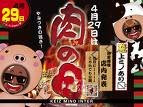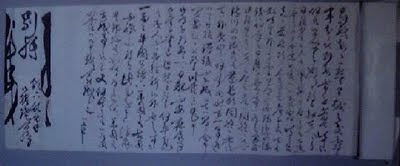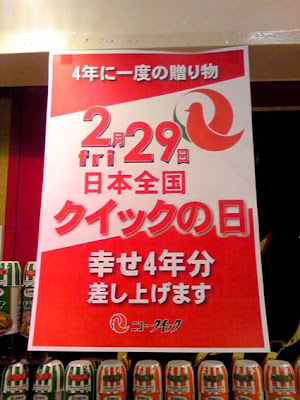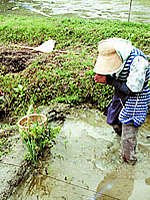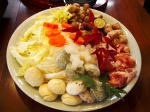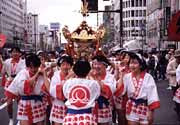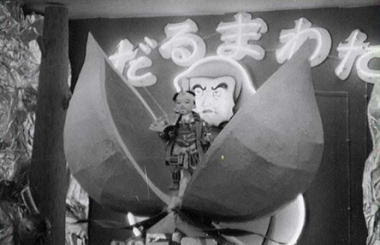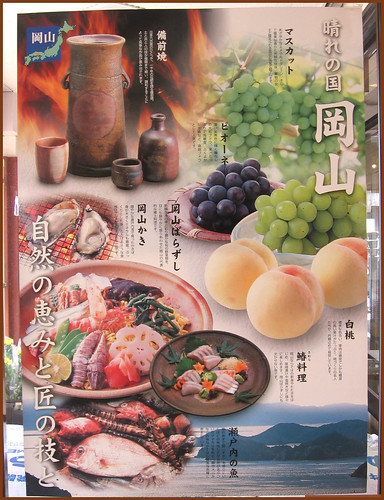[ . BACK to WORLDKIGO TOP . ]
::::::::::::::::::::::::::::::::::::::::::::::::::::::::::::::::::::::::::::::::::::::::::::::::::::
Beef (gyuuniku) Rindfleisch, Rind
***** Location: Japan
***** Season: Various
***** Category: Humanity
*****************************
Explanation
gyuuniku 牛肉 beef, often steak
Japanese beef is often very fat, with marble fat, "like frost" (shimofuri).
There are quite a few regional varieties of cows, some are treated like royalty and classical music is played in the shed to keep them happy.
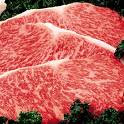 wagyuu, wagyu 和牛 Japanese beef
wagyuu, wagyu 和牛 Japanese beef
from Japanese cattle.
biifu ビーフ beef
roosuto ロースト― roast
:::::::::::::::::::::::::::::::::::::::::::::::::::::::::::::::::::::::::::::::::::::::::::::::::::::
Wagyū (和牛)
refers to several breeds of cattle genetically predisposed to intense marbling and to producing a high percentage of oleaginous unsaturated fat. The meat from wagyū cattle is known worldwide for its marbling characteristics, increased eating quality through a naturally enhanced flavor, tenderness and juiciness, and thus a high market value. Several areas in Japan are famous for the quality of their Wagyu cattle, and ship beef bearing their areas' names. Some examples are Kobe, Mishima and Ōmi beef.
The wagyū cattle's genetic predisposition yields a beef that contains a higher percentage of omega-3 and omega-6 fatty acids[1] than typical beef. The increased marbling also improves the ratio of monounsaturated fats to saturated fats.
Wagyū were initially introduced to Japan as a beast of burden to help cultivate rice. By order of the Shogun, the cowherd in Japan was closed and eating meat from any four legged animal was prohibited from 1635 to 1838. Because of Japan's rugged terrain and isolated areas, different breeding and feeding techniques were used such as massaging or adding beer or sake to their feeding regimen.
It is suggested that this was done to aid in digestion and induce hunger during humid seasons but appears to have no effect on the meat's flavor. Massaging may have been to prevent muscle cramping on small farms in Japan in which the animals did not have sufficient room to use their muscles.
There are five major breeds of wagyū (wa means "Japanese" and gyū means "cow"): Japanese Black, Japanese Brown, Japanese Polled, Japanese Shorthorn, and Kumamoto Reds. Japanese breed names include: Tajima, Tottori, Shimane, Kochi and Kumamoto. Kumamoto Prefecture is famous for their red wagyū cattle. The more famous black variety has their origins in Kobe.
© More in the WIKIPEDIA !
:::::::::::::::::::::::::::::::::::::::::::::::::::::::::::::::::::::::::::::::::::::::::::::::::::::
sukiyaki is one of the most favorite beef dishes.
 source : www.daiei.co.jp
source : www.daiei.co.jp
sukiyaki, suki-yaki 鋤焼 (すきやき) "food prepared on a spade"
gyuunabe 牛鍋(ぎゅうなべ)、with beef
uosuki 魚すき(うおすき)、with fish
okisuki 沖すき(おきすき)、with seafood
torisuki 鶏すき(とりすき)、with chicken or pheasant
udonsuki 饂飩すき(うどんすき) with udon
kigo for winter
Sukiyaki (Japanese: 鋤焼 or more commonly すき焼き; スキヤキ) is a Japanese dish in the nabemono (Japanese steamboat) style.
often prepared with warishita すき焼きわりした soy sauce and dashi mix
Warishita and Soy Sauce
It consists of meat (usually thinly sliced beef) as the secular, raw part of the meal (namakusa), and a lot of vegetarian ingredients like firm tofu, konnyaku and vegetables, slowly cooked or simmered at the table, alongside vegetables and other ingredients of the sacred aspect of a meal (shoojin), in a shallow iron pot in a mixture of soy sauce, sugar, and mirin (warishita). Before being eaten, the ingredients are usually dipped in a small bowl of raw, beaten eggs.
In the 1890s when Japan was opened to foreigners, new cooking styles were also introduced. Cows, milk, meat, and egg became widely used, and sukiyaki was the most popular way to serve them. The first sukiyaki restaurant, Isekuma, opened in Yokohama in 1862.
© More in the WIKIPEDIA !
In Kanto, the warishita is put in the pot first, them meat and vegetables are added. In Kansai, only lard is used for the first frying of meat, which is eaten dipped in a raw egg to make it a bit cool. Then warishita is poored in the pot, other ingredients, vegetables and tofu are added with more meat and all is let to stew for a moment.
In Kyoto, the oldest restaurant,
Mishima Tei 三嶋亭, had a story to tell about the beginning of the restaurant there.
The founder, a samurai from Kyoto, Mishima Kanekichi and his love Tei made it to Nagasaki to get married and there studied the new ways of eating meat, which was not common in Buddhist Japan. Then they went back to Kyoto and established their restaurant in 1873. The present owner is the 5th generation and keeps up the high standard for meet dishes.
They serve sukiyaki in a hexagonal pan. First some white sugar is placed on the black pan and then one piece of beef for each guest. While it grills on the sugar it makes a delicious sound. This first bite is pure beef, so the guest can enjoy the taste of the carefully choosen marbled meat.
Then the other ingredients are added, warishita poored over it and all is cooked in the usual way.
. . . CLICK here for Photos of Mishima Tei Restaurant !
:::::::::::::::::::::::::::::::::::::::::::::::::::::::::::::::::::::::::::::::::::::::::::::::::::::
 shabushabu しゃぶしゃぶ shabu shabu
shabushabu しゃぶしゃぶ shabu shabu
Shabu-shabu (しゃぶしゃぶ, also spelled syabu-syabu) is a Japanese variant of hot pot. The dish is related to sukiyaki in style, where both use thinly sliced meat and vegetables, and usually served with dipping sauces. However, it is starkly different in taste as it more closely resembles its predecessor, the Chinese hot pot; shabu-shabu is more savory and less sweet than sukiyaki. It is considered a
winter dish but is eaten year-round.
The dish is traditionally made with thinly sliced beef, though modern preparations sometimes use pork, crab, chicken, duck, or lobster. Most often, tender ribeye steak is used, but less tender cuts such as top sirloin are also common. A more expensive meat, such as Wagyu, may also be used for its enhanced flavor and texture.
Shabu-shabu is usually served with tofu and vegetables, including hakusai, chrysanthemum leaves, nori (edible seaweed), onions, carrots, shiitake mushrooms and enokitake mushrooms. In some places, Udon, Mochi and/or harusame noodles may also be served.
Shabu-shabu was introduced in Japan in the 20th century with the opening of a Shabu-shabu restaurant "Suehiro"[1] in Osaka. The name of Shabu-shabu was named when Suehiro served it. After that, Suehiro registered the name of shabu-shabu as a trademark in 1955. The cuisine rapidly spread through Asia and is now a popular dish in Western countries as well. Together with sukiyaki, shabu-shabu is a common dish in tourist hot-spots, especially in Tokyo, but also in local Japanese neighborhoods (colloquially called "Little Tokyos") in countries such as the United States.
Its origins are traced back to the Chinese hot pot known as "shuan yang rou". Shabu-shabu is most similar to the original Chinese version when compared to other Japanese steamboat dishes (nabemono) such as sukiyaki.
© More in the WIKIPEDIA !
rei shabushabu, reishabu れいしゃぶ / 冷しゃぶ cold shabushabu
a delicacy in summer. Often served on salad leaves.
often pork meat is also used.
rei-shabu
. . . CLICK here for Photos !
:::::::::::::::::::::::::::::::::::::::::::::::::::::::::::::::::::::::::::::::::::::::::::::::::::
ume beef, Osaka Ume beef 大阪ウメビーフ "plum beef"
From the farm of Harano Shooji
He feeds his 50 cows pickled umeboshi every day, about 1 kg. The cattle does not get any antibiotics, and they seem to like the umebosh. It keeps the cows happy (with an alcohol content of about 12 percent) and free of stress.
The plums come from Choya Umesho in Habikino, Osaka.
. . . CLICK here for Photos !
:::::::::::::::::::::::::::::::::::::::::::::::::::::::::::::::::::::::::::::::::::::::::::::::::::
wagyuu tsukudani 和牛佃煮 sweetly simmered Japanese beef
prepared in some areas of Japan, often an expensive present for travellers.
. . . CLICK here for Photos !
yaki-niku, yakiniku 焼き肉 (やきにく, 焼肉) grilled slices of meat
Korean-style barbecued beef is quite popular too.
Many restaurants specialize in this kind of food for a group of people to enjoy whilst socializing.
. . . CLICK here for Photos !
© More in the WIKIPEDIA !
. WKD
binchootan 備長炭 Binchotan. special charcoal from Wakayama
used for grilling food
:::::::::::::::::::::::::::::::::::::::::::::::::::::::::::::::::::::::::::::::::::::::::::::::::::
gyuudon 牛丼 (ぎゅうどん) bowl of rice with beef
. . . CLICK here for Photos !
mega gyuudon メガ牛丼 expecially large portion
nikujaga 肉じゃが "meat and potatoes"
from Kure city, Hiroshima
The town of Kure is one of the originagors of this dish, together with Maizuru.
Toogoo Heihachiro of the Marine is said to have introduced this dish to the mariners after eating it in Europe.
In Kure, they do not use water but may queen potatoes, beef, shirataki noodles and onions.
If you add also carrots and green peas, it is no longer nikujaga from Kure city.
The city of Kure is also lately trying to introduce the Marine gourmet,
kaigun gurume 海軍グルメ, giving some dishes the names of the ships which were most famous for this dish.

Unweit von Hiroshima liegt die Hafenstadt Kure, ein wichtiger Stützpunkt der japanischen Kriegsmarine. Der Admiral Toogoo Heihachiroo (1847-1934) lernte bei seinen Fahrten in Europa ein Gericht kennen, das er seinen Soldaten auf dem Schiff unterwegs zu Essen gab und das von Kure aus ganz Japan eroberte – die inzwischen so beliebte Hausmannskost „Kartoffeln mit Fleisch“ (
nikujaga).
In Kure werden dazu nur Kartoffeln der Sorte May Queen, Rindfleischscheiben, Shirataki-Konnyaku-Fadennudeln und Zwiebeln zusammen ohne Wasser eingekocht. In anderen Gegenden kommen nach Geschmack noch Möhren und Erbsen dazu.
Die Stadt Kure bemüht sich mit diesem und anderen Gerichten, die auf Schiffen der Kriegsmarine gegessen werden, einen „Marine-Gourmet“ (kaigun gurume) populär zu machen und viele Restaurants in Kure servieren inzwischen diese Gerichte für die Touristen.
:::::::::::::::::::::::::::::::::::::::::::::::::::::::::::::::::::::::::::::::::::::::::::::::::::::
hikiniku ひき肉 minced meat, Hackfleisch
It is produced into
meat balls ミートボール
CLICK here for PHOTOS !
hamburgers ハンバーグ
CLICK here for PHOTOS !
and German steak dishes ジャーマンステーキ (jaaman suteeki)
CLICK here for PHOTOS !
With different sauces these dishes can be varied as mother likes it.
Later on not only beef was used for minced meat, but also pork, chicken and others.
:::::::::::::::::::::::::::::::::::::::::::::::::::::::::::::::::::::::::::::::::::::::::::::::::::
Regional Beef
This LIST is not complete. Let me know your information.
akaushi, aka-ushi あかうし "red cows"
from Mount Aso, Kyushu, also Tosa and other regions.
At Mt. Aso, they make
Aso hayashi raisu 阿蘇ハヤシライス hashee rice with this beef

阿蘇あかうしバーガー Aso Akaushi Hamburger 赤牛ハンバーガー
Akaushi cattle is richly marbled with fat and produces a very tender, flavorful expensive variety of steak which is used in Kobe restaurants.
The largest purebred group of the Wagyu breed of Akaushi cattle outside Japan is located in Harwood, Texas, owned by HeartBrand Beef.
© More in the WIKIPEDIA !
.................................................................................
Hidakagyuu 日高牛 beef from Hidaka
Hokkaido
Iki gyuu 壱岐牛 beef from Iki Island, Nagasaki pref.
CLICK here for PHOTOS !
Ishigaki gyuu 石垣牛 beef from Ishigaki, Okinawa
Matsuzaka gyuu 松阪牛 beef from Matsuzaka
Mie prefecture
. . . CLICK here for Photos of the most expensive beef filet !
Ami-yaki, amiyaki 網焼き grilled on a net
Grilled beef from Matsuzaka beef is a speciality of Mie prefecture
Mishima Ushi, Mishima gyuu 見島牛 beef from Mishima Island
Yamaguchi prefecture
. . . CLICK here for Photos !
On this small island, most elderly farmers still have some of these cows and some oxen. They take a longer time to grow for food, but are kept like members of the family in the barn. About 20 cows are brought to slauter to the mainland every year.
Mokkori gyuu もっこり牛
brand of beef produced in Minamikata town, Hokkaido
. . . CLICK here for Photos !
Oki no shima 隠岐の島 Island group of Oki no shima
On the island 知夫里島 they have a long tradition of keeping cows, more than 800 years. The cows are strong and can swim through the sea to the next island, they are called "the sea-crossing, swimming cows" of Okinoshima.
Nowadays, the whole island is used as common grazing land for the calfs and cows. In winter, when the island becmes barren, the cows have to swim to nearby Shimazu island 島津島.
. . . CLICK here for Photos !
The famous ekiben lunch from Matsue uses this beef.
. WASHOKU
Regional Dishes from Shimane prefecture
Oomi gyuu 近江牛 beef from Omi
Shiga prefecture
. . .
Oomi Beef in the Edo period Ii Naosuke and Mito no Nariaki
Sagagyuu 佐賀牛 beef from Saga
Shinshuu wagyuu 信州和牛 beef from Shinshu province, Matsumoto
beef from Nagano Prefecture, also called "Shinshu premium beef."
It comes from cattle with black hair kuroge-wagyu (黒毛和牛).
. . . CLICK here for Photos !
Shiraoigyuu 白老牛 beef from Shiraoi
Hokkaido. rather dark brown to black cows.
. . . CLICK here for Photos !
Tajimagyuu 但馬牛 beef from Tajima Hyogo prefecture
Tajima cattle (但馬牛, Tajima-ushi or Tajima-gyu) is one of the types of black Wagyu cattle in Japan. Many tajima cattle are born in Hyōgo Prefecture and raised as stock for famous beef such as Kobe beef and Matsuzaka beef.
Tajima cattle has been fed from old times in Tajima Province. In the Shoku Nihongi, it is written that “The Tajima-ushi is fit to cultivate the fields, to carry burdens and to eat.” In ancient times, people ate tajima-ushi in their own houses.
© More in the WIKIPEDIA !
Takamorigyuu 高森牛 beef from Takamori
Yamaguchi
CLICK here for PHOTOS !
http://www.takamori-beef.com/
Yonezawa gyuu 米沢牛 beef from Yonezawa
BEEF in the Washoku Database
::::::::::::::::::::::::::::::::::::::::::::::::::::::::::::::::::::::::::::::::::::::::::::::::::::
quote
U.K. 'wagyu' cross-breed an affordable favorite
By WILLIAM HOLLINGWORTH , Japan Times 2009
LONDON
"Wagyu" beef has long been the preserve of Britain's exclusive restaurants and London's high-end stores, like Harrods.
However, the average bloke in the street will soon be able to have a taste of the prized wagyu thanks to a major supermarket chain that wants to bring luxury foods to everyone.
ASDA, part of the Wal-Mart group, has just started breeding cross Holstein-wagyu cattle for its supermarkets and hopes to start selling the product in early 2011.
Although not pure wagyu meat, which retails for as much as $170 per kg, the meat will have many of the characteristics of
wagyu (which literally means Japanese cattle) that make it so appetizing to gourmets.
With wagyu, the fat is more evenly distributed than in other meats and it has a highly marbled appearance. The fine strands of unsaturated fat in the meat melt when it is cooked, giving it a greater depth of flavor than other kinds of beef.
Because the store is producing its own wagyu and does not have to import anything, the store is confident it can keep costs down and reduce the price to the consumer.
"wagyu beef is the best in the world, but until now it has been the preserve of the extremely well to do. We want to make it affordable for the average man in the street," said Pearce Hughes, the company's agricultural development manager.
ASDA took semen from two pedigree black wagyu bulls in Britain. Breeders in southern Scotland then inseminated a Holstein cow and a few months later their efforts paid off with the birth of the first wagyu-cross, which they have named Inochi, which means life in Japanese.
The bulls used in the breeding process are the result of implanting Australian full-blood wagyu embryos into cows in Europe. The bulls' genes are linked to the Kedeka and Fujiyoshi lines.
Following the successful birth, farmers will now inseminate further Holstein cows on a Yorkshire farm and the plan is to produce 2,500 wagyu-Holsteins a year, providing 750 tons of meat.
But Hughes adds, "wagyu-cross-Holstein is deemed as the ultimate cross in Japan because the two breeds lay down marbling in exactly the same way, producing top quality meat superior to wagyu-cross-Angus or Red Devon. It has been known for wagyu-Holstein beef to match the eating quality of purebred wagyu in taste trials."
The meat will be less fatty than pure wagyu, but bosses at ASDA believe this will appeal to health-conscious Britons.
Pure wagyu have been bred in Wales on a small scale since 2000. Farmer David Wynne Finch imported some embryos of mixed black wagyu and implanted them into some standard cross-bred beef cows. He has a herd of around 30 wagyu.
The wagyu breed has only been exported out of Japan on three occasions.
While the breed is considered indigenous to Japan, DNA testing has shown it was influenced by European breeds brought about through cross-breeding in the early 1900s.
In Japan, it is claimed that farmers massage their wagyu cows to ensure the fat is evenly distributed. They are also fed grain and given beer to stimulate appetite.
source : Japan Times, October 2009
*****************************
Worldwide use
Rindfleisch
Steak, Rinderbraten
*****************************
Things found on the way
*****************************
HAIKU and SENRYU
すき焼きへ世話をする箸食べる箸
sukiyaki e sewa suru hashi taberu hashi
chopsticks
for the sukiyaki pot
for eating
Sagara Wataru 相良渉
:::::::::::::::::::::::::::::::::::::::::::::::::::::::::::::::::::::::::::::::::::::::::::::::::::::
ステーキの皿の人参いつも北
suteeki no sara ni ninjin itsumo kita
a plate with steak
and the carrots always
facing north
Moriya Akitoshi 守屋明俊
Reference
:::::::::::::::::::::::::::::::::::::::::::::::::::::::::::::::::::::::::::::::::::::::::::::::::::::
すき焼きの母へ残った葱豆腐
sukiyaki no haha e nokotta negi toofu
left over for mother
from the sukiyaki pot ...
leek and tofu
Makido 牧戸俊翠
*****************************
Related words
*****
WASHOKU : INGREDIENTS
. WASHOKU
Milk and Milk Products
WASHOKU : NIKU ... MEAT
:::::::::::::::::::::::::::::::::::::::::::::::::::::::::::::::::::::::::::::::::::::::::::::::::::
